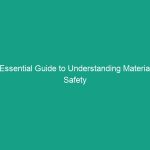Introduction
Good morning team! Today, we are diving into an essential topic that can significantly impact our Workplace Safety: Essential Emergency Action Plans (EAPs). Understanding and implementing effective EAPs is crucial for protecting ourselves and our colleagues during emergencies. By the end of this Toolbox Talk, you will comprehend the significance of EAPs and how they can transform our response to unexpected situations.
Emergencies can happen at any time and can range from natural disasters to workplace accidents. Preparing for these incidents not only safeguards our health but also boosts our confidence in handling crises. Let’s explore why EAPs are fundamental to our Safety culture.
Understanding Essential Emergency Action Plans (EAPs)
So, what exactly are Essential Emergency Action Plans (EAPs)? In simple terms, EAPs are documented Procedures that outline the steps to take during an emergency. This includes evacuation routes, communication strategies, and designated roles for employees. EAPs are designed to minimize risks and ensure a swift and efficient response when emergencies occur.
The importance of EAPs in Workplace Safety cannot be overstated. They provide a clear framework that guides our actions during crises, helping us to remain calm and collected. Furthermore, EAPs enhance our ability to protect not only ourselves but also our coworkers and visitors. A common misconception is that only large organizations require EAPs. In reality, every workplace, regardless of size, should have a tailored EAP to address its specific Hazards and risks.
Key Hazards, Risks, and Safety Considerations
When we think about emergencies, various hazards come to mind. These can include:
- Fires
- Earthquakes
- Floods
- Medical emergencies
- Workplace violence
- Chemical spills
Each of these scenarios presents unique risks and challenges that necessitate specific responses. For example, a fire might require immediate evacuation, while a chemical spill may need containment and specialized cleanup. Failing to adhere to established safety protocols can lead to severe consequences, including injuries, property damage, and even fatalities.
Understanding these risks emphasizes the critical nature of having a well-structured EAP in place. It not only prepares us for the worst but also fosters a culture of safety within our organization.
Best Practices, Procedures, & Actionable Advice
Now that we understand the importance of EAPs, let’s discuss some Best Practices for developing and implementing these plans.
1. Assess Your Workplace Risks
The first step in creating an EAP is to conduct a thorough risk assessment. Identify potential hazards specific to your work Environment. Engage with employees to gather input on potential risks they observe in their daily operations.
2. Develop Clear Procedures
Your EAP should contain clear and concise procedures, including:
- Evacuation routes and assembly points
- Roles and responsibilities of staff
- Communication protocols during an emergency
- First aid and medical response guidelines
3. Provide Training
Once the EAP is developed, conduct training sessions for all employees. This ensures everyone knows what to do in an emergency, reducing panic and confusion. Regular drills should also be scheduled to practice these procedures, allowing employees to become familiar with their roles and responsibilities.
4. Regularly Review and Update
Emergencies can evolve, and so should your EAP. Regularly review and update your plan to reflect changes in the workplace, such as new equipment, personnel, or hazards.
5. Communicate Openly
Encourage open communication about safety concerns and suggestions for improving the EAP. Employee feedback is invaluable in refining emergency procedures.
Case Study: Fire Drill Incident
Consider a recent incident where a small fire broke out in a storage room. Thanks to our well-practiced EAP, employees evacuated quickly, and the fire was contained with minimal damage. This situation illustrates the importance of having a robust plan in place and the effectiveness of regular drills.
Regulations, Standards, and Compliance
Compliance with safety Regulations is critical. The Occupational Safety and Health Administration (OSHA) has specific requirements regarding EAPs, including the necessity for all employers to have a written plan in place. Understanding these regulations not only protects our employees but also shields our organization from legal repercussions.
Additionally, adhering to ISO Standards related to Workplace Safety can help enhance our EAP, ensuring we meet industry Best Practices and maintain a safe working environment.
Employee Engagement & Discussion
Now, let’s open the floor for discussion. What safety challenges have you encountered related to emergency situations? How can we improve our existing EAP? Your experiences and insights are crucial for fostering a safer workplace.
Conclusion & Key Takeaways
In conclusion, Essential Emergency Action Plans (EAPs) are a vital component of our Workplace Safety strategy. By understanding the key hazards, implementing best practices, and ensuring compliance with regulations, we can create a safer working environment for everyone.
Remember, safety is a collective responsibility. Your proactive engagement and commitment to following our EAP can make all the difference in an emergency situation. Thank you for your attention and dedication to safety!


